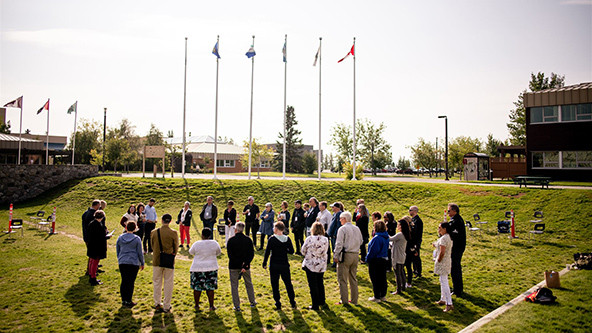 Presidents and Reconciliation Leads from colleges and universities across Canada gather during a five-day Institute on Reconciliation to learn from each other and advance reconciliation across the postsecondary sector. (Photo by Alastair Maitland Photography)
Presidents and Reconciliation Leads from colleges and universities across Canada gather during a five-day Institute on Reconciliation to learn from each other and advance reconciliation across the postsecondary sector. (Photo by Alastair Maitland Photography)
Higher education has long been a crucial part of social progress, through its core functions of teaching and learning. But as society’s needs change, a new type of post-secondary institution is growing in prominence: one that also plays a key role as a civic actor, driving local and regional community development.
It takes more than good intentions, however, to develop a community-driven agenda. It takes rewiring institutional structures and cultures for collaboration. Yet to achieve that, a field catalyst is needed to spark and amplify the development of a new social infrastructure. To change the hierarchical systems and incentive structures of a centuries-old institution requires fundamentally reordering the “components and structures that cause a system to act a certain way” (as Wharton and Evans describe systems change). Since systems rarely change on their own, aligning action with intent requires a “field catalyst,” or what Hussein, Plummer, and Breen have described as “an intermediary organization that amplifies the efforts of others, that helps to build “a marketplace for ideas and a framework for action.”

In 2016, recognizing the need for increased collaboration, and the lack of organizations working across silos and sectors in Canadian higher education, the McConnell Foundation began exploring how it might play the role of field catalyst. At the McConnell Foundation, we work not only as a funder, but also as a strategic learning partner, convener, capacity builder, and neutral broker. We were therefore well-positioned to play a bigger role in fostering relationships between innovators, influencers, administrators, faculty, and policy makers in order to accelerate and scale the adoption of social innovation practices in postsecondary. Launching the Re-Code initiative to do this was a natural evolution in our 80+ year history of working in higher education.
We believe that the higher education sector is uniquely positioned to invent and scale solutions to contemporary societal challenges, given its role in knowledge generation and transfer, its array of physical, human, and financial assets, and the myriad community relationships it sustains. Our role is to help universities and colleges identify creative and new ways these assets can be deployed in service of community and societal well-being. Our vision is that postsecondary institutions work in concert with communities, using these assets to tackle societal challenges, and are deemed successful if their communities are thriving.
Catalyzing the Ecosystem
While many postsecondary institutions in Canada envision driving community and social impact, the scale and complexity of the education sector limits the impact any single institution can have (and sector change is beyond the mandate of any one institution). Systems leadership is called for, or “seeing the larger system...fostering reflection and more generative conversations….and, shifting the collective focus from reactive problem solving to co-creating the future,” as Peter Senge and Hal Hamilton write. Member organizations like the national networks representing universities and colleges—as well as sector-specific organizations, such as those representing students, faculty, business officers, etc—play a critical coordinating role, but there often remains a need to propel sector-wide innovation in ways beyond these organizations’ purview and capacity. (For example, member organizations often do not have a “Social R&D” unit.)
Re-Code aims to fill in the gaps, mainstreaming innovations that could potentially shift the system in positive directions. By surfacing innovative ideas, connecting clusters of individuals working under similar motivations, and injecting resources (funding, tools, knowledge, human resources), we take on the risk of testing progressive ideas and the burden of scaling promising ones. This allows projects to get to a scale at which larger membership organizations can get behind them, and other funders can see proof of concept.
Membership organizations have deep expertise in their area of the sector, but Re-Code is topic-agnostic: our strength lies not in depth, but in breadth. We foster close relationships with multiple parts of the institution (senior leaders, administrators, faculty, students) as well as external stakeholders (government, member organizations, philanthropic organizations and funders), which allows us to draw connections, make visible different ways of working, and connect unlikely allies.
Field Catalyzing in Action
Despite an abundance of creative ideas within the sector, the pathways to translating those into impactful projects can be opaque or simply not exist. This is where a field catalyst plays a role.
A recent project we supported illustrates how we lay in new pathways. In response to COVID-19 and faculties’ race to pivot to an online fall semester, a new idea began circulating: for universities to collaboratively create a repository of the strongest digital resources for high-enrollment courses, to help faculty accelerate their course development over the summer. As interest grew around this concept, we noted that it seemed to appeal to individuals occupying a variety of roles in the sector (faculty members, deans, provosts), that it wouldn’t fall neatly under the mandate of any single member organization, and that—because it had never been done before—it carried a great deal of risk.
Re-Code is well-positioned to work in these kinds of situations, where there exists potential opportunity, but also a number of gaps. We hired a coordinator to convene the interested schools, organize working groups, and breathe momentum into the project. Within a few weeks, it took on a life of its own and a new consortium of schools sharing resources is getting ready to launch this fall.
A neutral broker with a systems-wide lens can support momentum for innovations emerging from within the sector. For example, in conversation with a partner, Yukon College—widely regarded as a leader in decolonization and indigenization, regularly receiving requests for advice and site visits by other schools—we realized there was a need for capacity building and sharing across the sector, and that Yukon College was naturally placed to do this. We therefore saw an opportunity: as a single institution, they lacked the resources and convening power to take on a sector-wide project, but the potential was there.
We convened a few partners and began planning what would become a first-of-its-kind 5-day institute on reconciliation, hosting 60 presidents and Indigenous leads from universities and colleges across Canada. The connections and commitments made there have translated into measurable changes across the sector, accelerating progress in this important space.
Re-Code’s strategy of “amplifying and clustering innovations” comes to life in this example: the potential existed in the system, but merely needed a catalyst. Our role was merely to connect the champions, offer a small amount of funding to lay a pathway where there was none before, and allow the idea to take off.
We’re already seeing evidence of systems change, a shift in how schools work with each other and with communities. We are seeing a higher degree of collaboration and more of an appetite for projects that have sector-wide (versus campus-specific) impact, as well as an increase both in the number of institutions concerned with their social impact (and in the degree to which they focus on it). In 2017 and then in 2020, we held roundtables with presidents to discuss the role of universities in community engagement, and witnessed that the narrative has shifted toward seeing an inherent responsibility of university to community and society, and as a result, more permeable boundaries between campus and community, and, by association, more resources being diverted to community engagement.
Reflection and Lessons
The McConnell Foundation’s activities have been framed by a focus on relationships, favoring collaborations built on trust, and working with those who share similar values. For us, understanding the postsecondary system means understanding relationship dynamics. We have learned many lessons about navigating postsecondary, and share those here as mental models about how schools work, making visible different relationship dynamics:
- School governance is not a traditional hierarchy but looks more like a mountain range: different peaks represent students, alumni, faculty, president, the board etc. Each institution has its own unique mountain range and therefore each has its own unique power structure. When working with a postsecondary institution, it is vital to have a picture of its mountain range and which peak you are trying to influence and for what purpose. In an institution that is well known for its research and long history, the faculty and alumni peaks are probably quite high. By contrast, at a newer school more focused on community engagement and undergraduate education, the student peak might be among the highest.
- Many institutions, especially larger ones, are run like fiefdoms which can make it hard to work across the organization. It can be pragmatic to work with the part of the institution that has the most capacity in the area you are trying to influence. This often means working with the presidents for visioning, the vice-presidents for institutional traction and deans and administrators for execution. Additionally, your approach often has to be top-down and bottom-up, as Marina Kim and Angie Fuessel observed earlier in this series. Re-Code worked with University and College Presidents to help set programmatic direction (see here, here and here) and then with the appropriate administrators to help implement the priority activities.
- When working with multiple—or even competing institutions—it can be easier to start with a larger societal purpose that is above and beyond what any one school can do on their own, such as searching for common ground. In the Canadian context, this has been reconciliation, though pursuing advancements on mental health and EDI have been big topics that lend themselves to rich and collaborative field building.
- That said, while it is easy for us to ask schools to think and act like a movement, they are, in practice, organizations that need to be mindful of their self-interest. It’s therefore easier to work with schools that aren’t natural competitors, as they are more likely to not be threatened by collaboration.
We are continually surprised by the high degree of collegiality among senior leadership in Canadian higher education. The people we are lucky enough to work with are keen to learn from each other, and are strong believers in the transformative power of higher education. First and foremost, they want the system to deliver on its potential for tackling contemporary societal challenges. Knowing that this is top of mind for our partners makes it easier to propose ideas and build collaboration. There is genuine interest in collectively figuring out how to work better together, and this runs counter to the stereotype of a university leadership putting their institution first. We are grateful to have been on this learning journey with our partners and to have played a role in helping bring their vision to life.
When working in sectors that are fragmented and tend toward competitiveness (such as postsecondary), it can be useful to consider what activities might help build collaboration to catalyze systemic change. For Re-Code, we take a vision of systems change that focuses on the relationships between the component parts and not the component parts themselves. As such, our efforts have always focused on creating reasons to build, and pathways to cement, strong trusting relationships. We believe that this lesson has broad applicability and would encourage others who are concerned about their efforts being tantamount to boiling the ocean, to consider how this approach might create deep and long-lasting systemic shifts in your sector.
Support SSIR’s coverage of cross-sector solutions to global challenges.
Help us further the reach of innovative ideas. Donate today.
Read more stories by Kelly Hodgins & Chad Lubelsky.

